engine RENAULT KANGOO 1997 KC / 1.G Engine And Peripherals Owners Manual
[x] Cancel search | Manufacturer: RENAULT, Model Year: 1997, Model line: KANGOO, Model: RENAULT KANGOO 1997 KC / 1.GPages: 208
Page 92 of 208

FUEL SUPPLY
Antipercolation device
13
When the ignition is switched off, the coolant temperature monitoring mode begins.
E7J Engine
Monitoring mode
Water temperature≥ 101°C
Coolant temperature ≤ 96°C Cooling fan assembly control time
≥ 10 minutes
Cooling fan assembly stops
Exit from monitoring mode
The monitoring mode is left 2 minutes after switching off the ignition in cases where the coolant
temperature is not greater than or equal to 101°C or once the coolant temperature falls below 92°C.
no
yes
nono
yes yes
High speed cooling fan assembly command
13-12
Page 93 of 208
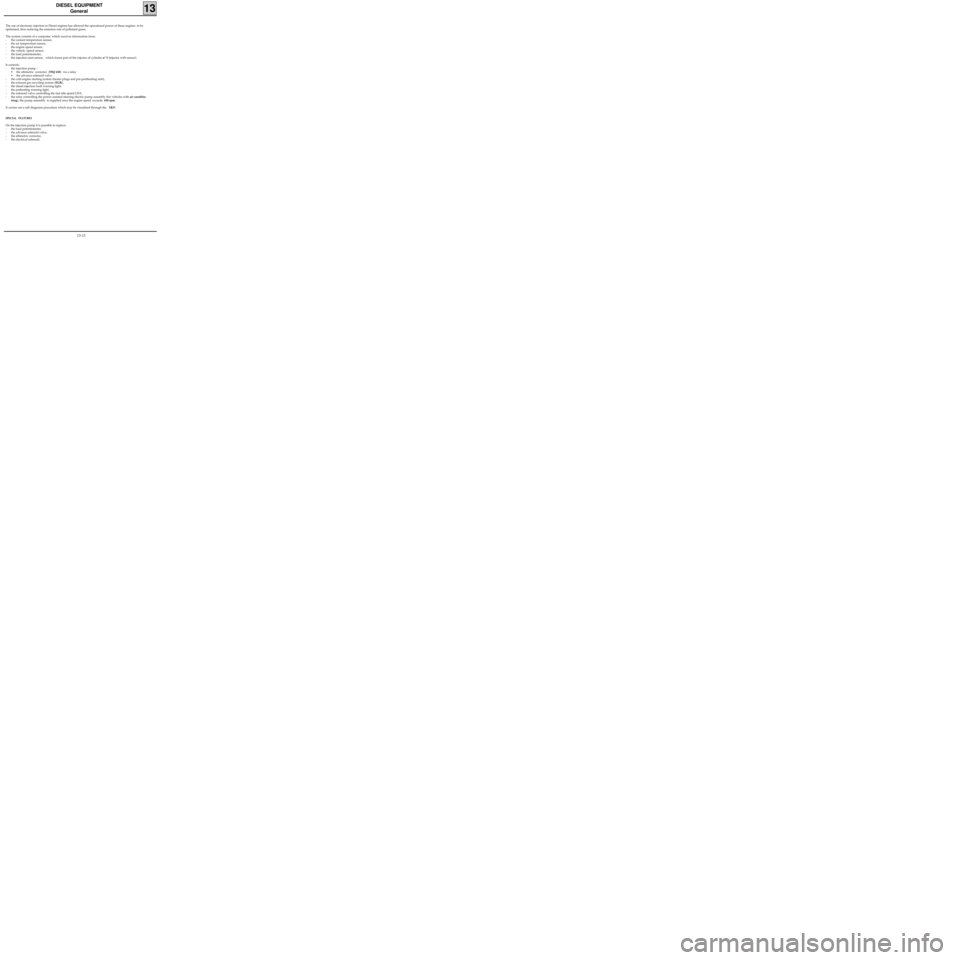
DIESEL EQUIPMENT
General
13
The use of electronic injection in Diesel engines has allowed the operational power of these engines to be
optimised, thus reducing the emission rate of pollutant gases.
The system consists of a computer, which receives information from:
- the coolant temperature sensor,
- the air temperature sensor,
- the engine speed sensor,
- the vehicle speed sensor,
- the load potentiometer,
- the injection start sensor, which forms part of the injector of cylinder n° 3 (injector with sensor).
It controls :
- the injection pump :
• the altimetric corrector (F8Q 630) via a relay
• the advance solenoid valve.
- the cold engine starting system (heater plugs and pre-postheating unit),
- the exhaust gas recycling system (EGR),
- the diesel injection fault warning light,
- the preheating warning light,
- the solenoid valve controlling the fast idle speed LDA,
- the relay controlling the power assisted steering electric pump assembly (for vehicles with air conditio-
ning), the pump assembly is supplied once the engine speed exceeds 650 rpm.
It carries out a self diagnosis procedure which may be visualised through the
XR25.
SPECIAL FEATURES
On the injection pump it is possible to replace:
- the load potentiometer,
- the advance solenoid valve,
- the altimetric corrector,
- the electrical solenoid.
13-13
Page 94 of 208
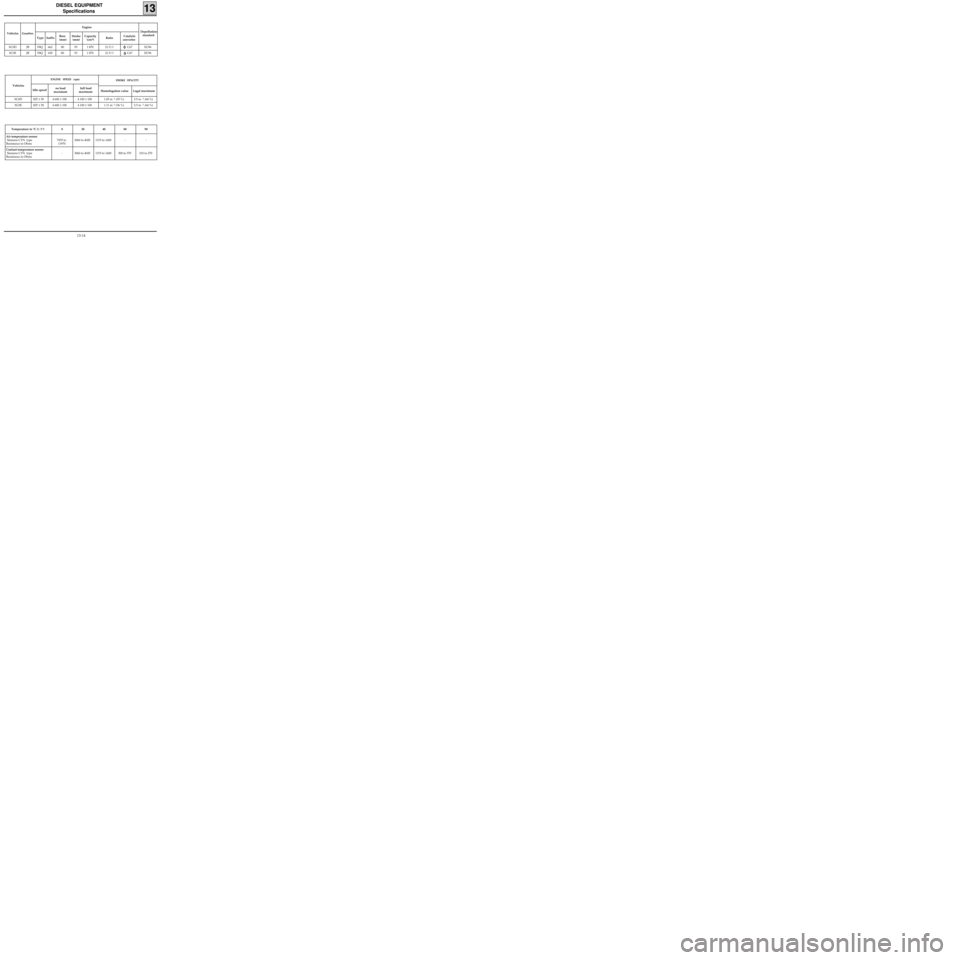
DIESEL EQUIPMENT
Specifications
13
Vehicles GearboxEngine
Type SuffixBore
(mm)Stroke
(mm)Capacity
(cm
3)RatioCatalytic
converterDepollution
standard
XC0D JB F8Q 662 80 93 1 870 21.5/1 C67 EU96
XC0E JB F8Q 630 80 93 1 870 21.5/1 C67 EU96
Vehicles
ENGINE SPEED (rpm)
Idle speedno load
maximumfull load
maximum
SMOKE OPACITY
Homologation value Legal maximum
XC0D 825 ± 50 4 600 ± 100 4 100 ± 100 1.05 m
-1 (35 %) 2.5 m -1 (64 %)
XC0E 825 ± 50 4 600 ± 100 4 100 ± 100 1.11 m
-1 (36 %) 2.5 m -1 (64 %)
Temperature in °C (± 1°) 0 20 40 80 90
Air temperature sensor
Siemens CTN type
Resistance in Ohms7470 to
119703060 to 4045 1315 to 1600 - -
Coolant temperature sensor
Siemens CTN type
Resistance in Ohms- 3060 to 4045 1315 to 1600 300 to 370 210 to 270
13-14
Page 98 of 208

DIESEL EQUIPMENT
Location of components
13
20 EGR valve
13047-1R
7Engine speed sensor
13048R
87970R
17Diesel injection fault warning light
18Preheating warning light
Warning light illuminates when ignition is
switched on during preheating phase.
12839S
C Power assisted steering pump assembly relay
HAltimetric corrector relay
LInjection locking relay
MDiesel heating relay
13-18
Page 101 of 208
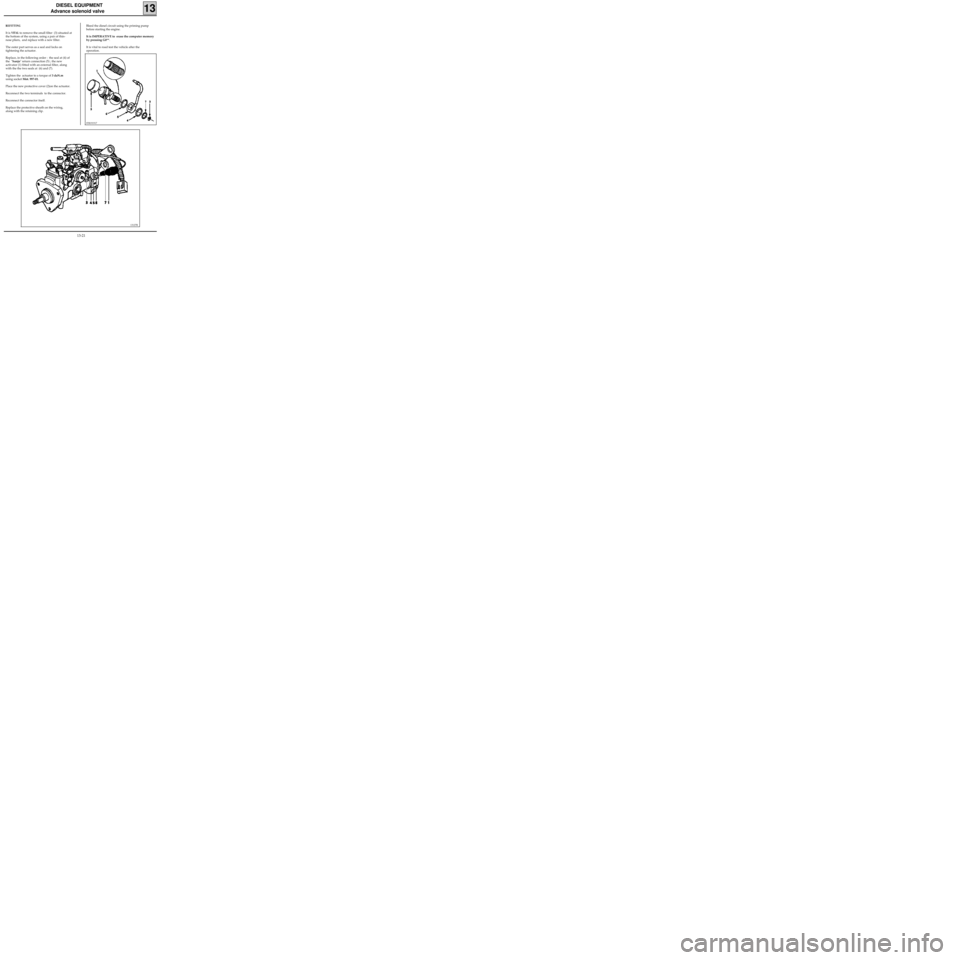
DIESEL EQUIPMENT
Advance solenoid valve
13
ITB191917
REFITTING
It is VITAL to remove the small filter (3) situated at
the bottom of the system, using a pair of thin-
nose pliers, and replace with a new filter.
The outer part serves as a seal and locks on
tightening the actuator.
Replace, in the following order : the seal at (4) of
the "banjo" return connection (5) ; the new
activator (1) fitted with an external filter, along
with the the two seals at (6) and (7).
Tighten the actuator to a torque of 3 daN.m
using socket Mot. 997-01.
Place the new protective cover (2)on the actuator.
Reconnect the two terminals to the connector.
Reconnect the connector itself.
Replace the protective sheath on the wiring,
along with the retaining clip.Bleed the diesel circuit using the priming pump
before starting the engine.
It is IMPERATIVE to erase the computer memory
by pressing G0**.
It is vital to road test the vehicle after the
operation.
13127R
13-21
Page 104 of 208
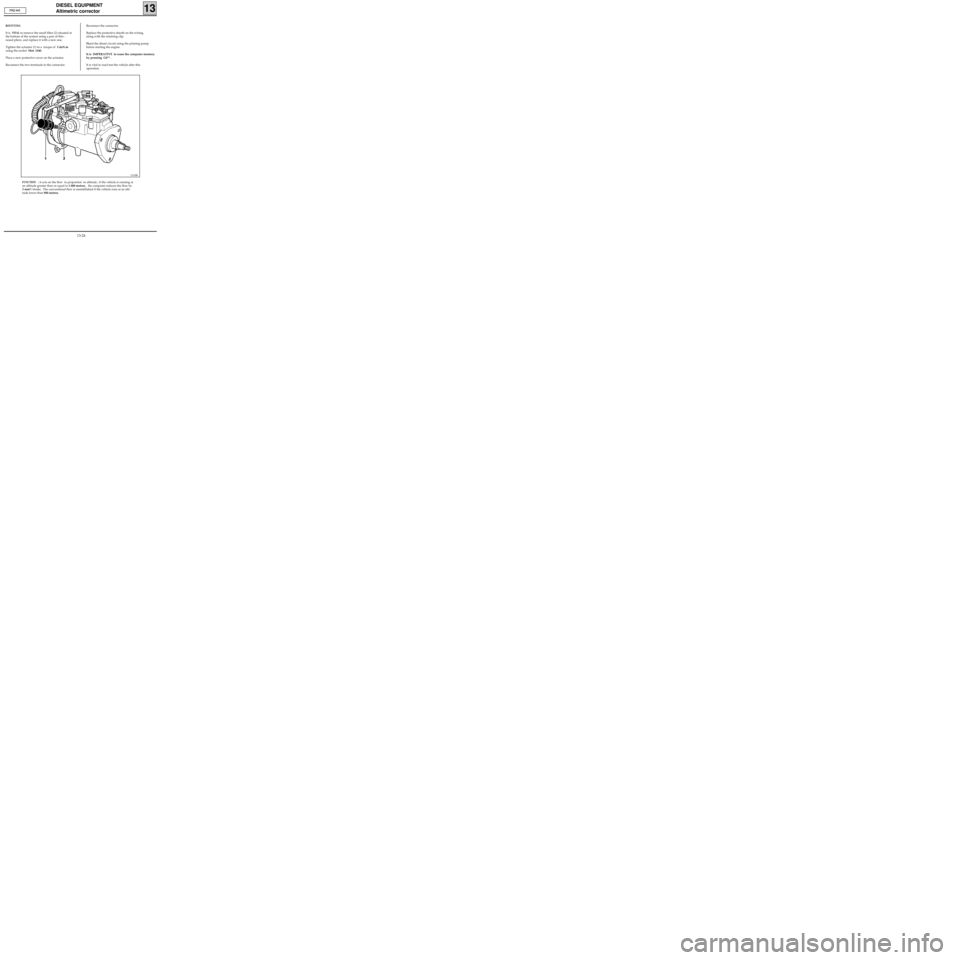
DIESEL EQUIPMENT
Altimetric corrector
13
REFITTING
It is VITAL to remove the small filter (2) situated at
the bottom of the system using a pair of thin -
nosed pliers, and replace it with a new one.
Tighten the actuator (1) to a torque of 3 daN.m
using the socket Mot. 1440.
Place a new protective cover on the actuator.
Reconnect the two terminals to the connector.Reconnect the connector.
Replace the protective sheath on the wiring,
along with the retaining clip.
Bleed the diesel circuit using the priming pump
before starting the engine.
It is IMPERATIVE to erase the computer memory
by pressing G0**.
It is vital to road test the vehicle after this
operation.
13128R
F8Q 662
FUNCTION : it acts on the flow in proportion to altitude ; if the vehicle is running at
an altitude greater than or equal to 1 000 metres, the computer reduces the flow by
3 mm
3/stroke. The conventional flow is reestablished if the vehicle runs at an alti-
tude lower than 900 metres.
13-24
Page 107 of 208

DIESEL EQUIPMENT
Coded solenoid valve
13
On this type of vehicle, the replacement of the
solenoid valve and of the coded electronic unit (A)
requires the removal of the injection pump from
the engine.
REMOVAL
With the pump on the bench, remove the protec-
tive fittings at (B).
These are secured by shear bolts which may be re-
moved either :
- using a small cold chisel or a punch and hitting
on the conical heads of bolts (C), (D) and (E)
to loosen them,
- using tool Mot. 1372 for bolt (F), drilling it
using the 4 mm diameter drill (drilling depth
approximately 4 mm) and the large diameter
drilling guide tube on the fitting side (2).
Use extractor (3) and its handle to remove it .
REFITTING
Tighten the fuel cut off solenoid valve to a torque
of 2 daN.m.
Refit a heat shrink cover on the fuel cut off sole-
noid, ensuring the wiring is correctly routed.
Refit the fittings using shear bolts and observing
their location and that of the spacers,
(depending on fitting).
IMPORTANT : using a torque wrench, tighten the
bolts, then remove the bolt heads by bending
them using a tube inserted in the bolt heads.
Location of bolts :
D :
∅ 5 x 25 mm ; torque =0.55 daN.m
C and F :
∅ 6 x 40 mm ; torque =1.2 daN.m
E :
∅ 5 x 33 mm ; torque =0.55 daN.m
Refit the cable of the fast idle speed LDA and
tighten the cable grip, leaving 2 mm play.
Refit the injection pump on the engine.
13-27
Page 112 of 208

DIESEL EQUIPMENT
Injection warning light
13
OPERATING PRINCIPLE OF THE DIESEL INJECTION WARNING LIGHT ON THE INSTRUMENT PANEL
On switching on the ignition, the diesel injection fault warning light is illuminated. It extinguishes as the en-
gine begins to run.
•Fault in a component of the injection assembly
Faults in the following components may cause the warning light to illuminate :
- injector with sensor
- advance solenoid valve,
- engine speed sensor ,
- load lever potentiometer,
- pre-postheating (according to version).
13-32
Page 113 of 208

DIESEL EQUIPMENT
Pre-postheating control
13
The pre-postheating function is controlled by the
computer, which controls the preheating plug re-
lay housing.
1) Ignition - Preheating
The preheating process is divided in two
phases :
a) Variable preheating
This is dependent on the coolant tempera-
ture, on the battery voltage and on alti-
tude (internal computer sensor) when the
ignition is switched on (the preheating
warning light illuminates).b) Fixed preheating
After the preheating warning light has
extinguished (variable preheating), the
plugs remain fed for 8 seconds before the
engine is started.
2) Starting the engine
During the action of the starter motor, the
four plugs are fed continuously.
3) Engine running - Postheating
The postheating also may be divided in two
phases:
a) Fixed postheating
After starting the engine, the plugs are
supplied simultaneously for a period of 10
seconds.
b) Variable postheating
Variable postheating begins when fixed
postheating ends. The time during which
the plugs are fed (continuously) depends
upon :
- the coolant temperature
- the engine speed ,
- the load (load potentiometer on pump
lever ).
Maximum preheating limit (battery vol-
tage lower than 9.3 volts and altitude hi-
gher than 2 000 m).
Minimum preheating limit (battery
voltage greater than 10.5 volts altitude
lower than 350 m).
13041S
13-33
Page 114 of 208
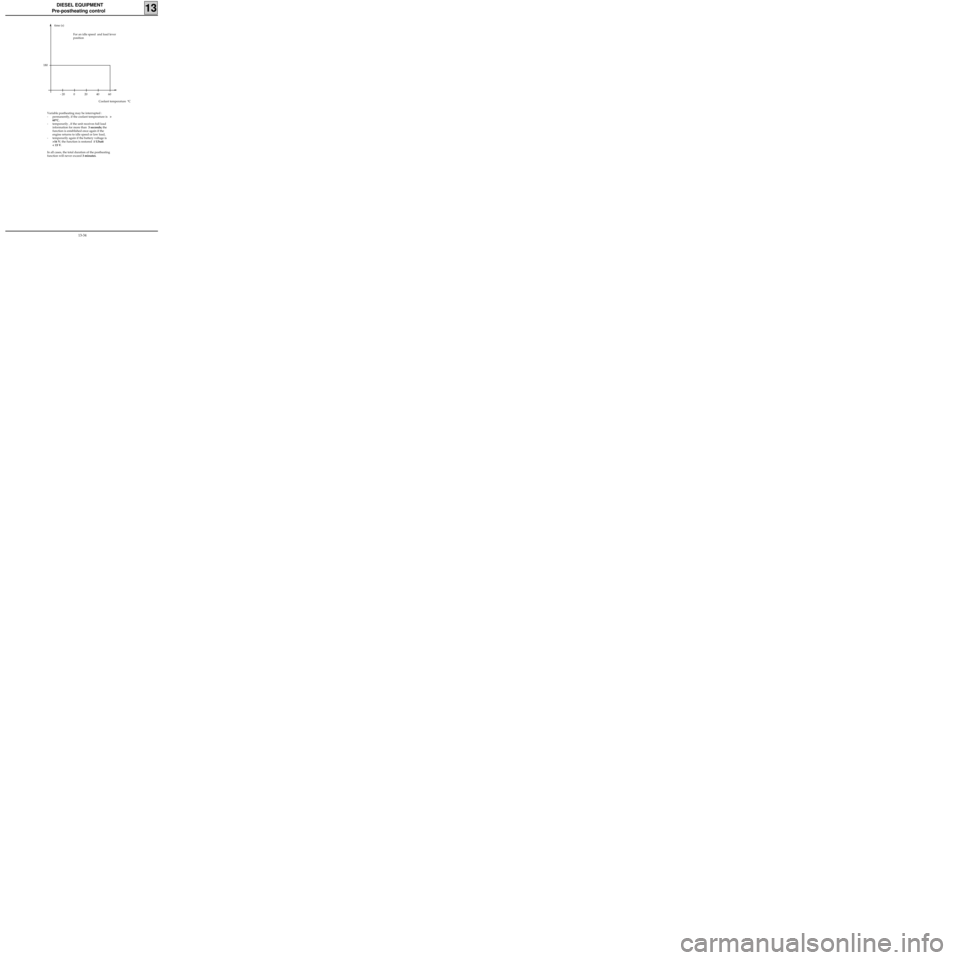
DIESEL EQUIPMENT
Pre-postheating control
13
- 20 180time (s)
For an idle speed and load lever
position
Coolant temperature °C0204060
Variable postheating may be interrupted :
- permanently, if the coolant temperature is >
60°C,
- temporarily , if the unit receives full load
information for more than 3 seconds; the
function is established once again if the
engine returns to idle speed or low load,
- temporarily again if the battery voltage is
>16 V; the function is restored if Ubatt
< 15 V.
In all cases, the total duration of the postheating
function will never exceed 3 minutes.
13-34